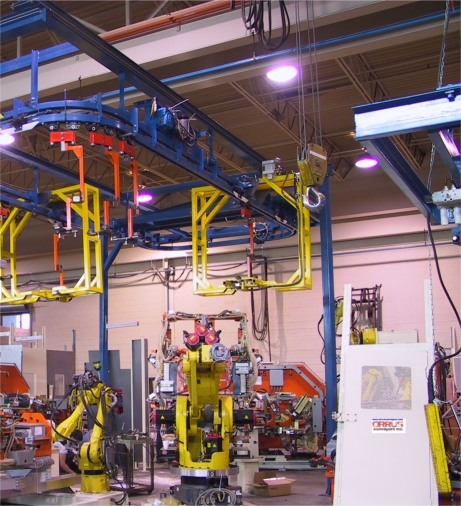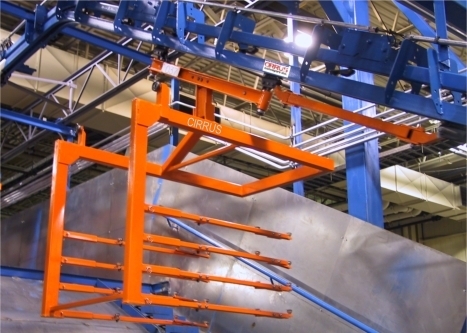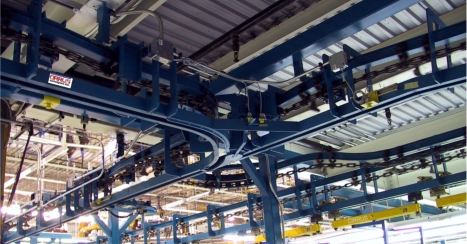
Slash Costs with Power & Free
Why Work-In-Progress Accumulates
One of the most interesting challenges in modern manufacturing is keeping a smooth flow of product moving through a series of uneven processes. In a perfect world, process ‘A’ would produce a widget and drop it on the doorstep of process ‘B’ exactly when ‘B’ wants it and so on down the line to ‘C’, ‘D’ and ‘E’ all the way to the shipping door.
There may be manufacturers that can achieve this kind of perfection, but by the very nature of what they’re making, most can’t — at least not with traditional methods. The timing of different processes varies too much. And some processes, such as washing or curing, often can’t be accelerated without enormous investments in manpower or equipment and real-estate.
How do you get faster processes to hand off smoothly to slower ones? Better yet, how do you do this without accumulating a pile of work-in-process which has to be broken down, perhaps sorted, and then transferred by forklift and human effort, to slower operations?
The Cost of Poor Product Flow
Direct manufacturing operations are not’t the only source of plant inefficiency. Many companies who work their manufacturing processes into peak efficiency still aren’t in a position to fully realize the value of these improvements. In some instances, the improvements make their situation worse, because the increased work-in-process compounds many of the existing product flow difficulties.
Here are some indicators that your operation may suffer from product flow inefficiency:
- You have unbalanced processes.
- You accumulate piles of unfinished product.
- You do too much inter-process handling.
- You do too much rework or scrap too much damaged product.
- You are always short of floor space.
- You are perpetually in danger of being run over by a fork lift truck.
- You have processes waiting for parts to arrive from other processes.
Each of the above points carries some measurable amount of financial penalty, either direct (e.g. repairing damaged goods, maintaining fork lift trucks) or indirect (e.g. lost production time, physical injury). If you can come to terms with these costs you will have a basis for comparison when looking for solutions.
Considering the Possibilities
A way of evaluating the costs is envisioning perfect product flow and assigning some honest numbers to the costs eliminated and values gained. In this perfect world, your product, on leaving any process, simply disappears until the exact moment it’s needed by the next process. Whereupon, it reappears on that process’s doorstep. Expect this to happen with little or no human intervention and without regard to any rate discrepancies between the operations. If you’re short of floor space, expect to gain some of it back. Expect to add no production machinery while maximizing the return from existing machines.
Are you dreaming in Technicolor or is this kind of thing actually achievable and can it be funded out of efficiency/productivity gains?


Entre Power & Free
A proven, tested technology exists which fulfills the vision described above that’s saving production costs right now, as you read this. It is: Cirrus Power and Free Overhead Conveyor.
Like ordinary overhead conveyor, its more well-known sibling, power and free conveyor gets your product off the floor into the unused overhead space that most plants never fully utilize.

Non Linear Storage and Delivery System
The similarity pretty-much ends there. Regular overhead conveyors are linear. They deliver product in the order it was loaded at the established speed of the conveyor. Power and free is random. Product carriers on power and free conveyors are independent of the power chain and of the main conveyor loop. A power and free product carrier is powered to its destination, yet it is free of the main loop, such that the order and timing of delivery is independent of other carriers. Carriers can be shunted into storage loops for accumulation by batch, and can be turned diagonally for denser storage, yet never touch. Carriers can be coded, identified and automatically routed by software working in the background. Furthermore, if your production uses robots, power & free carriers can easily be loaded and unloaded automatically at will.
Here are just some of the benefits that could vastly improve your product juggling act:
- Clear product flow bottlenecks, such that the right parts arrive at the correct operations in a continuous flow, even when production rates differ between operations.
- Create usable floor space, where once piles of work-in-process were accumulated.
- Eliminate expensive product re-handling and manual transportation.
- Reduce or eliminate rework and scrapping of damaged product.
- Deliver to other processes without costly and dangerous fork lift trucks.
- Enjoy an on-going record of work-in-progress indicating where product has been and where it’s going next.
- Secure smooth, pre-planned productivity.
For Power & Free call Cirrus
Cirrus Conveyors has the technology and the engineering know-how to bring power and free overhead conveyors into your production facility. If your product juggling act isn’t getting top reviews, take a look in your plant for some of the indicators of product flow inefficiency. Then give Cirrus a call. If your production warrants power and free, the system will pay for itself in short order.

